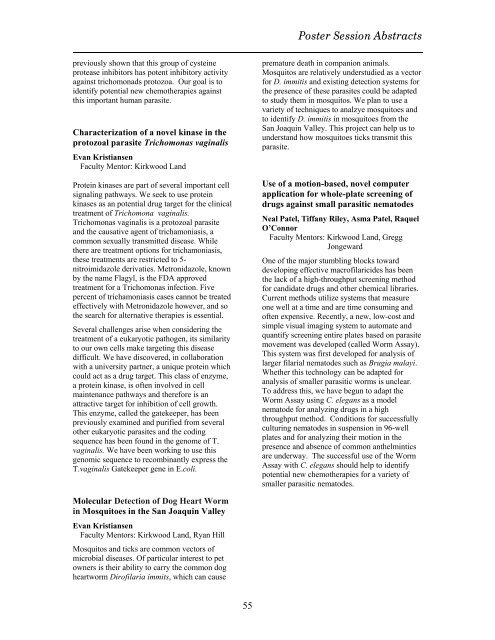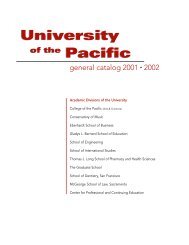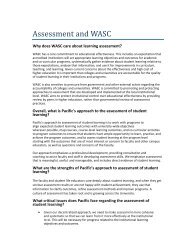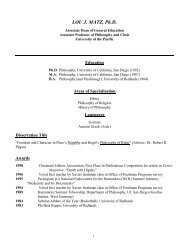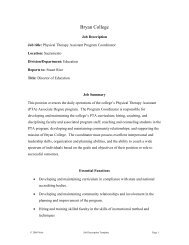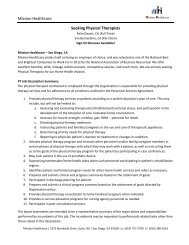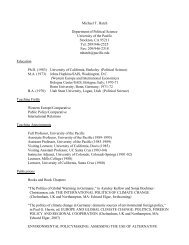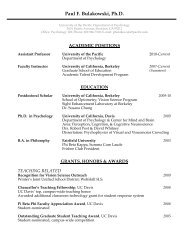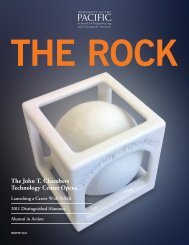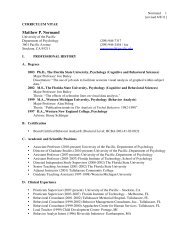purcc 2012 - University of the Pacific
purcc 2012 - University of the Pacific
purcc 2012 - University of the Pacific
Create successful ePaper yourself
Turn your PDF publications into a flip-book with our unique Google optimized e-Paper software.
Poster Session Abstracts<br />
previously shown that this group <strong>of</strong> cysteine<br />
protease inhibitors has potent inhibitory activity<br />
against trichomonads protozoa. Our goal is to<br />
identify potential new chemo<strong>the</strong>rapies against<br />
this important human parasite.<br />
Characterization <strong>of</strong> a novel kinase in <strong>the</strong><br />
protozoal parasite Trichomonas vaginalis<br />
Evan Kristiansen<br />
Faculty Mentor: Kirkwood Land<br />
Protein kinases are part <strong>of</strong> several important cell<br />
signaling pathways. We seek to use protein<br />
kinases as an potential drug target for <strong>the</strong> clinical<br />
treatment <strong>of</strong> Trichomona vaginalis.<br />
Trichomonas vaginalis is a protozoal parasite<br />
and <strong>the</strong> causative agent <strong>of</strong> trichamoniasis, a<br />
common sexually transmitted disease. While<br />
<strong>the</strong>re are treatment options for trichamoniasis,<br />
<strong>the</strong>se treatments are restricted to 5-<br />
nitroimidazole derivaties. Metronidazole, known<br />
by <strong>the</strong> name Flagyl, is <strong>the</strong> FDA approved<br />
treatment for a Trichomonas infection. Five<br />
percent <strong>of</strong> trichamoniasis cases cannot be treated<br />
effectively with Metronidazole however, and so<br />
<strong>the</strong> search for alternative <strong>the</strong>rapies is essential.<br />
Several challenges arise when considering <strong>the</strong><br />
treatment <strong>of</strong> a eukaryotic pathogen, its similarity<br />
to our own cells make targeting this disease<br />
difficult. We have discovered, in collaboration<br />
with a university partner, a unique protein which<br />
could act as a drug target. This class <strong>of</strong> enzyme,<br />
a protein kinase, is <strong>of</strong>ten involved in cell<br />
maintenance pathways and <strong>the</strong>refore is an<br />
attractive target for inhibition <strong>of</strong> cell growth.<br />
This enzyme, called <strong>the</strong> gatekeeper, has been<br />
previously examined and purified from several<br />
o<strong>the</strong>r eukaryotic parasites and <strong>the</strong> coding<br />
sequence has been found in <strong>the</strong> genome <strong>of</strong> T.<br />
vaginalis. We have been working to use this<br />
genomic sequence to recombinantly express <strong>the</strong><br />
T.vaginalis Gatekeeper gene in E.coli.<br />
premature death in companion animals.<br />
Mosquitos are relatively understudied as a vector<br />
for D. immitis and existing detection systems for<br />
<strong>the</strong> presence <strong>of</strong> <strong>the</strong>se parasites could be adapted<br />
to study <strong>the</strong>m in mosquitos. We plan to use a<br />
variety <strong>of</strong> techniques to analzye mosquitoes and<br />
to identify D. immitis in mosquitoes from <strong>the</strong><br />
San Joaquin Valley. This project can help us to<br />
understand how mosquitoes ticks transmit this<br />
parasite.<br />
Use <strong>of</strong> a motion-based, novel computer<br />
application for whole-plate screening <strong>of</strong><br />
drugs against small parasitic nematodes<br />
Neal Patel, Tiffany Riley, Asma Patel, Raquel<br />
O’Connor<br />
Faculty Mentors: Kirkwood Land, Gregg<br />
Jongeward<br />
One <strong>of</strong> <strong>the</strong> major stumbling blocks toward<br />
developing effective macr<strong>of</strong>ilaricides has been<br />
<strong>the</strong> lack <strong>of</strong> a high-throughput screening method<br />
for candidate drugs and o<strong>the</strong>r chemical libraries.<br />
Current methods utilize systems that measure<br />
one well at a time and are time consuming and<br />
<strong>of</strong>ten expensive. Recently, a new, low-cost and<br />
simple visual imaging system to automate and<br />
quantify screening entire plates based on parasite<br />
movement was developed (called Worm Assay).<br />
This system was first developed for analysis <strong>of</strong><br />
larger filarial nematodes such as Brugia malayi.<br />
Whe<strong>the</strong>r this technology can be adapted for<br />
analysis <strong>of</strong> smaller parasitic worms is unclear.<br />
To address this, we have begun to adapt <strong>the</strong><br />
Worm Assay using C. elegans as a model<br />
nematode for analyzing drugs in a high<br />
throughput method. Conditions for successfully<br />
culturing nematodes in suspension in 96-well<br />
plates and for analyzing <strong>the</strong>ir motion in <strong>the</strong><br />
presence and absence <strong>of</strong> common an<strong>the</strong>lmintics<br />
are underway. The successful use <strong>of</strong> <strong>the</strong> Worm<br />
Assay with C. elegans should help to identify<br />
potential new chemo<strong>the</strong>rapies for a variety <strong>of</strong><br />
smaller parasitic nematodes.<br />
Molecular Detection <strong>of</strong> Dog Heart Worm<br />
in Mosquitoes in <strong>the</strong> San Joaquin Valley<br />
Evan Kristiansen<br />
Faculty Mentors: Kirkwood Land, Ryan Hill<br />
Mosquitos and ticks are common vectors <strong>of</strong><br />
microbial diseases. Of particular interest to pet<br />
owners is <strong>the</strong>ir ability to carry <strong>the</strong> common dog<br />
heartworm Dir<strong>of</strong>ilaria immits, which can cause<br />
55


